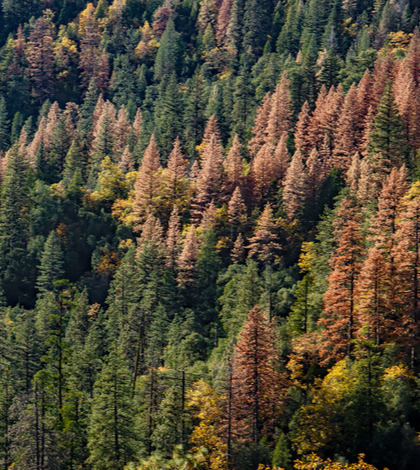The effects of California’s prolonged drought continue to be felt and seen throughout the state. The state and local water agencies continue to promote water conservation, dead vegetation can still be found in residential and commercial properties and, now, the United States Department of Agriculture (USDA) has announced that an addition 27 million trees – mostly conifers – have died in California since November 2016.
Most of the newly succumbed trees have died due to the five-plus year drought — 2011 to 2016 – or from infestations of bark beetles. Although California experienced record-breaking rains in the winter of 2016-2017, the drought and a dramatic rise in bark beetle infestation combined with rising temperatures have led to historic levels of tree die-off.
“The number of dead and dying trees has continued to rise, along with the risks to communities and firefighters if a wildfire breaks out in these areas,” said Randy Moore, Regional Forester of the USDA Forest Service, Pacific Southwest Region. “It is apparent from our survey flights this year that California’s trees have not yet recovered from the drought, and remain vulnerable to beetle attacks and increased wildfire threat. The USDA Forest Service will continue to focus on mitigating hazard trees and thinning overly dense forests so they are healthier and better able to survive stressors like this in the future.”
The California Tree Mortality Task Force (TMTF), comprised of more than 80 local, state and federal agencies, private utility companies, and with the support of Governor Jerry Brown’s office, continues to remove hazardous dead trees. Collectively TMTF members have felled and/or removed more than 860,000 dead trees including 480,000 felled/removed trees through the efforts of the USDA Forest Service.
In spite of the work of the work thus far by the TMTF and the USDA Forest Service, with more than 129 million dead trees on 8.9 million acres in the state, much work remains. The dead trees continue to pose a hazard to people and critical infrastructure, mostly centered in the central and southern Sierra Nevada regions of the state.
TMTF members are first focusing on public safety by removing dead and dying trees in high hazard areas. To further improve forest health, the USDA Forest Service and CAL FIRE have increased their pace and scale of prescribed fire. The USDA Forest Service has treated over 55,000 acres and CAL FIRE has completed over 33,000 acres in fuel treatment projects. By combining tree removal with prescribed fire, crews will be able to decrease overly dense stands of trees, reduce greenhouse gases, and protect communities across the state.
“Tree mortality at this magnitude takes on-going cooperation between public, non-profit and private entities,” said Chief Ken Pimlott, CAL FIRE director and California’s state forester. “California’s forests are a critical part of the state’s strategy to address climate change. By working together and using all the resources at our disposal we will be able to make more progress towards our common goal of healthier, more resilient forests that benefit all Californians.”
TMTF is capitalizing on the current tree mortality as an opportunity to collaborate on several fronts including public workshops about reforestation, public outreach in urban and rural areas, and awarding over $21 million in grants aimed to protect watersheds, remove dead trees and restore California’s forests. Collaboration on the efficient use of resources to protect public safety and build consensus around long-term management strategies for California’s forest lands are high priorities for TMTF.
But problems and issues in continuing the work of the USDA Forest Service in removing the state’s dead trees, protecting public safety and watersheds and in reforestation are evident.
The USDA Forest Service’s Regional Forester Moore noted, “To increase the pace and scale of this important work, we need to fix how fire suppression is funded. Last year fire management alone consumed 56 percent of the USDA Forest Service’s national budget. As fire suppression costs continue to grow as a percentage of the USDA Forest Service’s budget, funding is shrinking for non-fire programs that protect watersheds and restore forests, making them more resilient to wildfire and drought.”
 California Water News Daily Your Source For Water News in California
California Water News Daily Your Source For Water News in California


